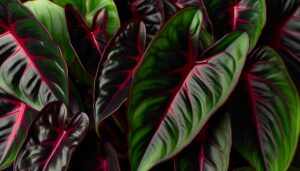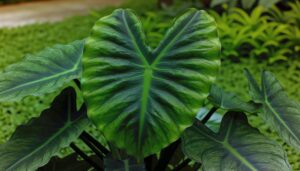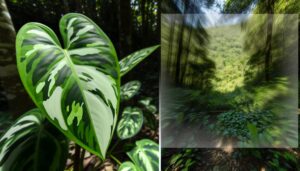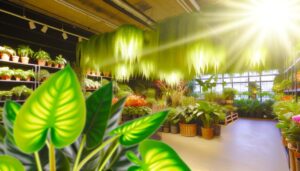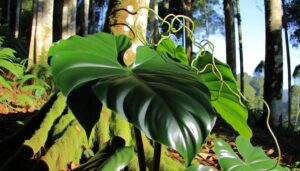What Is Philodendron Bipinnatifidum Burgundy?
Philodendron bipinnatifidum 'Burgundy' is a distinctive cultivar characterized by its large, deeply lobed leaves with striking burgundy undersides. Renowned for its upright growth and significant lignification, it thrives in bright, indirect light and requires well-draining, nutrient-rich soil.
Native to Brazil's tropical regions, it exhibits rapid growth, supported by an extensive aerial root system for nutrient absorption. Common care concerns include pest infestations and root rot.
Proper maintenance includes consistent moisture and balanced fertilization. If intrigued by its unique properties and care requirements, you can explore the botanical intricacies and best growing practices further.
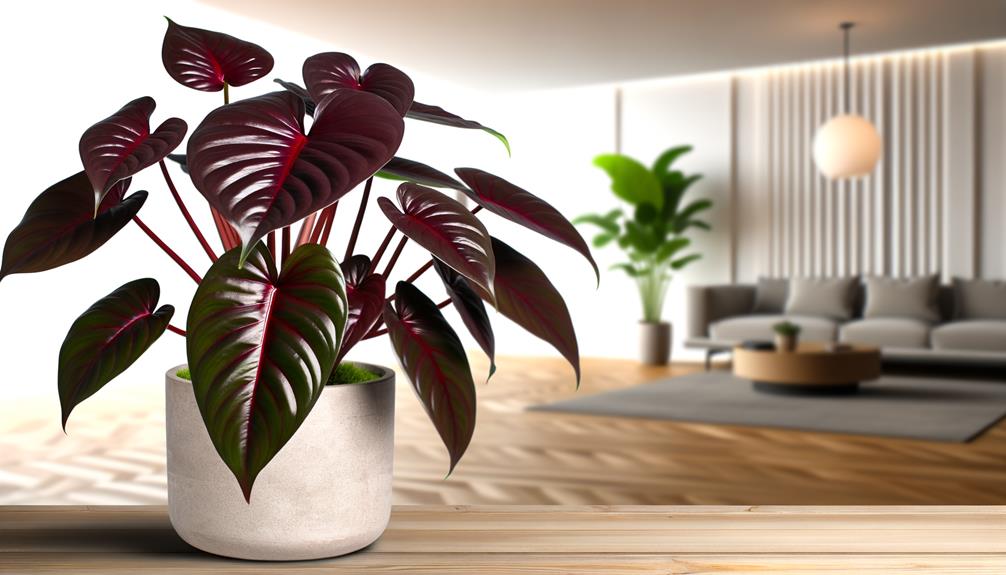
Key Takeaways
- Philodendron Bipinnatifidum Burgundy features burgundy-tinted, deeply lobed leaves with an upright growth habit.
- It thrives in bright, indirect light and requires well-draining, nutrient-rich soil.
- Originates from tropical South America and has a history of medicinal use by indigenous tribes.
- The plant enhances indoor air quality and creates a striking focal point in any space.
- It's easy to care for, tolerates low light, and prefers moderate to high humidity.
Unique Characteristics
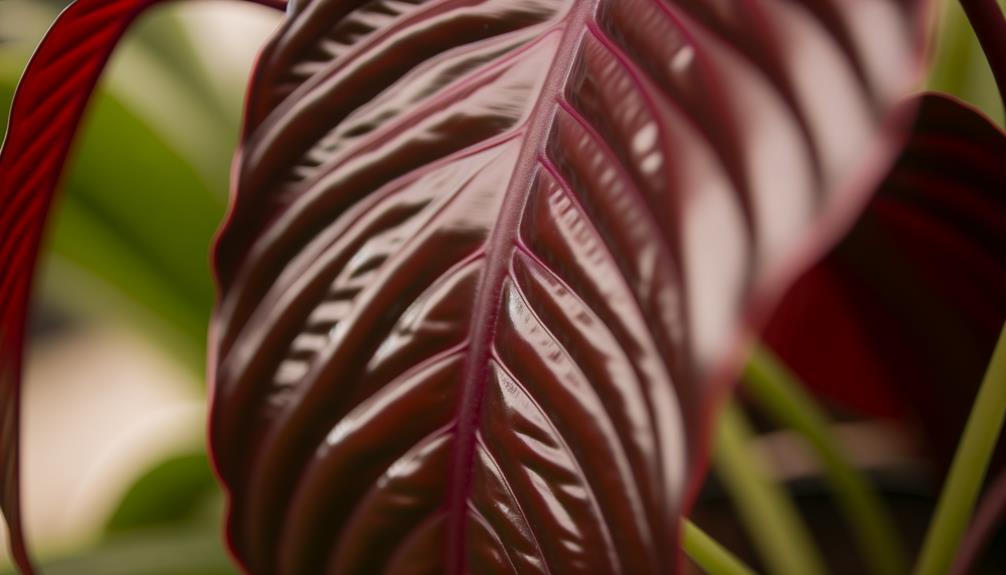
Philodendron Bipinnatifidum Burgundy exhibits a distinctive combination of deeply lobed, burgundy-tinted foliage and robust, upright growth habit, setting it apart from other members of the Philodendron genus.
The leaves are pinnately lobed, displaying a unique morphology that maximizes photosynthetic efficiency. The burgundy hues intensify under specific light conditions, contributing to its appeal as a decorative plant.
This species demonstrates significant lignification in its stems, which supports its substantial leaf structure and contributes to its vertical growth orientation. Additionally, the plant's aerial roots facilitate nutrient absorption and provide structural stability.
These attributes collectively endow Philodendron Bipinnatifidum Burgundy with an aesthetic and physiological uniqueness, appealing to both botanical enthusiasts and interior decorators seeking a striking foliage plant.
Care Requirements
To maximize growth and health of Philodendron Bipinnatifidum Burgundy, it is crucial to address its specific light and watering requirements. This plant thrives in bright, indirect light and needs consistent moisture without waterlogging.
Furthermore, a well-draining, nutrient-rich soil combined with regular, balanced fertilization will support its robust development.
Light and Watering Needs
Understanding the light and watering requirements is essential for maintaining the health and robustness of Philodendron bipinnatifidum 'Burgundy'.
This plant thrives in bright, indirect light, which simulates its natural understory habitat. Excessive direct sunlight can cause leaf burn, while insufficient light may lead to leggy growth and diminished vibrancy.
Optimal watering involves maintaining consistently moist soil without waterlogging. It is recommended to water when the top inch of soil feels dry to the touch. Overwatering can promote root rot, while underwatering may result in dehydration and leaf drop.
Humidity levels should be kept moderate to high, emulating tropical conditions. Regular misting or the use of a humidifier can aid in achieving the desired humidity levels.
Soil and Fertilization
Ensuring an ideal soil composition and appropriate fertilization regimen is crucial for the healthy growth and development of Philodendron bipinnatifidum 'Burgundy'.
This plant thrives in a well-draining, organic-rich substrate, ideally a mix of peat, perlite, and pine bark, which promotes aeration and moisture retention. Soil pH should be slightly acidic to neutral, ranging from 5.5 to 7.0.
Fertilization should be conducted bi-monthly during the growing season with a balanced, water-soluble fertilizer diluted to half strength. Essential macronutrients like nitrogen, phosphorus, and potassium, along with trace micronutrients, are critical for optimal foliar and root development.
Over-fertilization should be avoided as it can lead to nutrient buildup and potential root burn, compromising plant health.
Origins and History
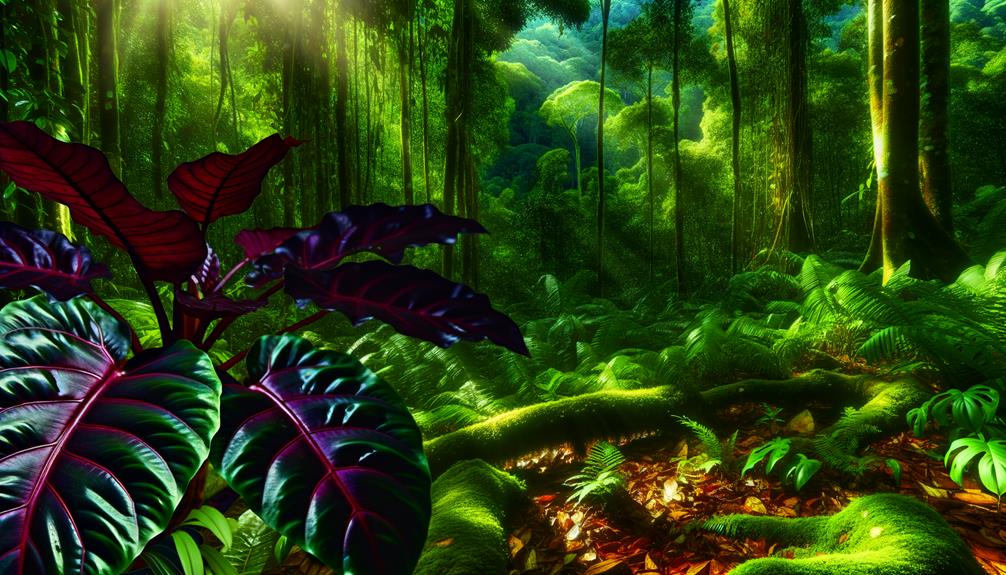
Originating from the tropical regions of South America, particularly Brazil, the Philodendron bipinnatifidum burgundy has a rich history intertwined with indigenous cultures and botanical exploration. This plant, known for its distinctive deeply lobed leaves and burgundy hues, has been a subject of fascination for botanists and horticulturists alike.
- Indigenous Uses: Native tribes utilized its foliage and roots for medicinal purposes, capitalizing on its purported therapeutic properties.
- Botanical Documentation: Early European explorers documented the species in the 19th century, leading to its classification within the Araceae family.
- Horticultural Development: Over the decades, selective breeding has enhanced its aesthetic appeal, making it a sought-after specimen in ornamental horticulture.
This plant's journey from the wild tropics to cultivated spaces underscores its enduring allure and botanical significance.
Growth and Development
The growth and development of Philodendron bipinnatifidum burgundy are characterized by its strong stem structure, expansive root system, and the emergence of its signature deeply lobed, burgundy-tinged leaves.
The plant exhibits a vigorous growth rate, with its stems developing a woody texture over time, providing structural support. Its root system is extensive and penetrative, enabling efficient nutrient and water uptake.
The foliage, with its distinctive burgundy hue, emerges in a pinnatifid pattern, enhancing its aesthetic appeal. Ideal growth conditions include well-draining soil, consistent moisture levels, and indirect sunlight, which promote healthy leaf coloration and overall importance.
As it matures, the Philodendron bipinnatifidum burgundy can attain a substantial size, making it a striking addition to horticultural collections.
Common Issues
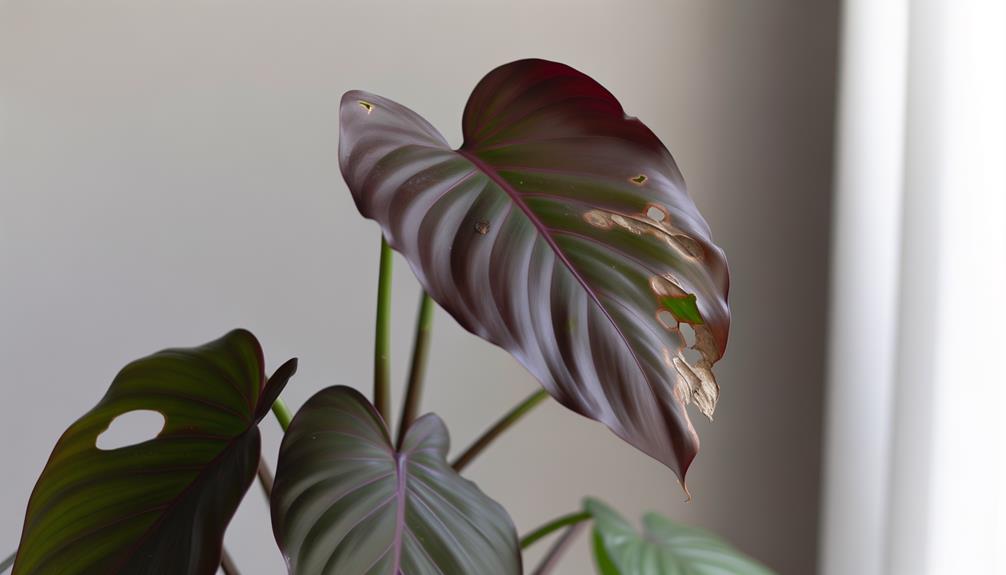
Encountering common issues such as pest infestations, root rot, and nutrient deficiencies can greatly impact the health and aesthetic appearance of Philodendron bipinnatifidum burgundy. These problems often arise due to suboptimal growing conditions.
For instance, excessive moisture can promote root rot, characterized by dark, mushy roots and wilting leaves. Nutrient deficiencies, particularly of nitrogen, magnesium, or iron, manifest as chlorosis or stunted growth. Pest infestations, including spider mites and aphids, can cause leaf discoloration and reduced vigor.
Common issues include:
- Pest Infestations: Look for spider mites, aphids, and mealybugs causing discoloration and leaf damage.
- Root Rot: Typically caused by overwatering, leading to dark, mushy roots.
- Nutrient Deficiencies: Inadequate nutrients result in chlorosis and stunted growth, often due to poor soil quality or improper fertilization.
Tips for Display
When considering the best presentation of Philodendron Bipinnatifidum Burgundy, it is important to identify locations with indirect sunlight and moderate humidity, such as near east-facing windows or in well-lit living rooms.
Incorporating this plant within a decor scheme that accentuates its deep burgundy foliage, such as minimalist or modern interiors, can enhance its visual appeal.
Additionally, utilizing decorative pots and stands that complement its vibrant coloration will further elevate its aesthetic presence.
Ideal Placement Spots
Positioning Philodendron Bipinnatifidum Burgundy in areas with indirect, bright light can optimize photosynthesis and promote vigorous growth. This tropical species thrives in environments that mimic its natural habitat.
Consider the following prime placement strategies:
- Near East or West-Facing Windows: These locations provide ample light without direct sun exposure, preventing leaf scorching.
- In Rooms with High Humidity: Bathrooms and kitchens with good ventilation offer the humidity levels ideal for this plant's growth.
- Away from Drafts: Positioning the plant away from air vents and frequently opened doors minimizes stress from temperature fluctuations.
These placements guarantee the Philodendron Bipinnatifidum Burgundy receives adequate light and environmental conditions, fostering healthy development and vibrant foliage.
Complementary Decor Ideas
How can the Philodendron Bipinnatifidum Burgundy be seamlessly integrated into your interior decor to enhance aesthetic appeal while promoting optimal plant health?
Position this vibrant species near natural light sources, such as east-facing windows, to optimize photosynthesis while highlighting its burgundy-hued foliage.
Utilize decorative ceramic or terracotta pots to complement the plant's robust structure and rich tones. In minimalist settings, pair with neutral-colored furnishings to create a striking focal point.
For a tropical ambiance, integrate with other large-leaf plants and wooden elements. Allow sufficient space for air circulation to prevent fungal infections.
Regularly rotate the plant to maintain symmetrical growth and even light exposure. These practices foster a harmonious blend of decor and botanical well-being.
Conclusion
Philodendron bipinnatifidum ‘Burgundy' embodies a confluence of distinctive characteristics, particular care requirements, historical importance, and developmental traits.
Its peak growth is dependent on following precise care protocols, stemming from its native habitats. Coincidentally, this species' resilience contrasts its vulnerability to common issues.
Effective display methods further improve its visual charm. This intricate balance of attributes makes Philodendron bipinnatifidum ‘Burgundy' a captivating subject for botanical study, blending natural grace with horticultural precision.

